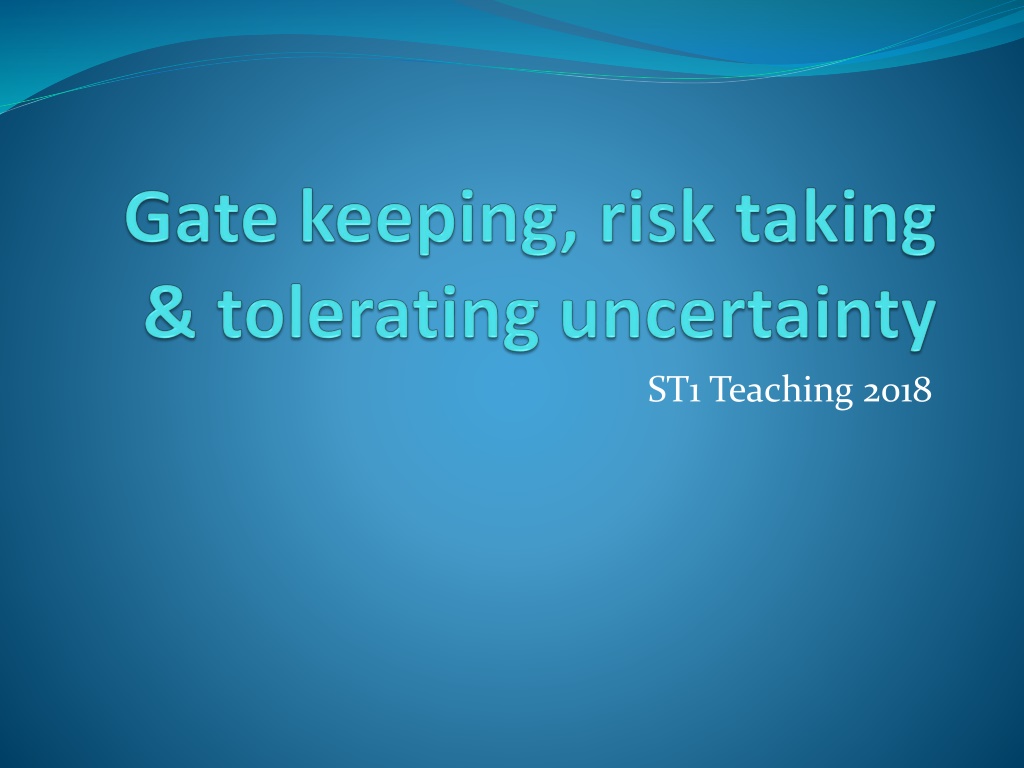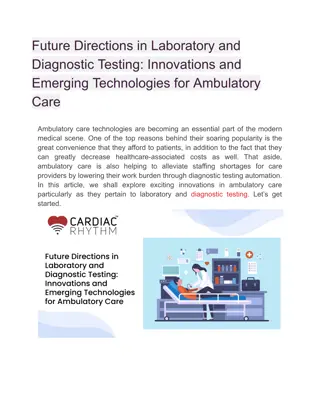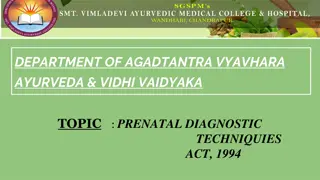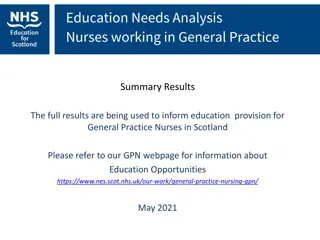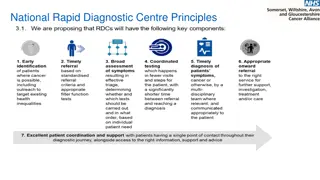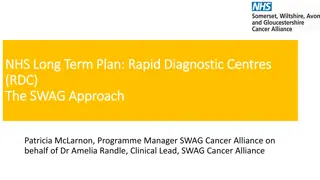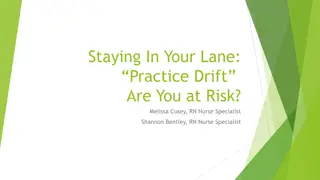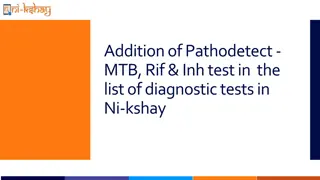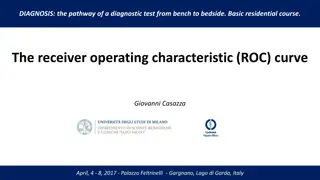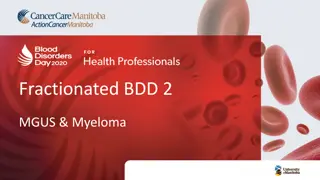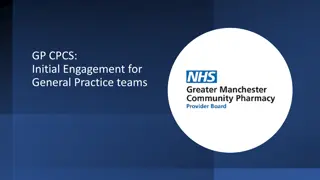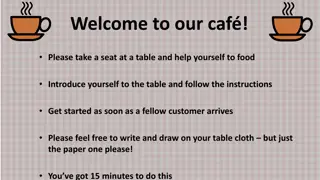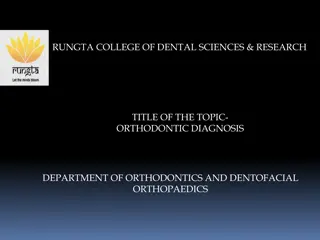Understanding Diagnostic Strategies and Gatekeeping in General Practice
Explore the complexities of diagnostic strategies such as Occam's razor and cognitive errors in medical decision-making, along with the gatekeeping function in general practice. Delve into topics like the toleration of uncertainty, managing vague presentations, and strategies for dealing with medically unexplained symptoms. Consider the pros and cons of gatekeeping, including holistic care and cost containment, while discussing the evolving role of GPs in healthcare.
Uploaded on Sep 23, 2024 | 0 Views
Download Presentation

Please find below an Image/Link to download the presentation.
The content on the website is provided AS IS for your information and personal use only. It may not be sold, licensed, or shared on other websites without obtaining consent from the author. Download presentation by click this link. If you encounter any issues during the download, it is possible that the publisher has removed the file from their server.
E N D
Presentation Transcript
Intro video https://www.youtube.com/watch?v=EtAG3e3JLNI
Recap on diagnostic strategies. Theories of diagnosis such as Occam s razor, Hickam sdictum and Popper s black swan. Hyopthetico-deductive model (iterative diagnosis) Cognitive errors such as: premature closure - Arriving at a conclusion before gathering the critical data and not revisiting it. Base rate neglect when you hear hooves .. Availability bias - Relating the case to an easily recalled example. Confirmation bias - taking a hx to confirm a theory
Aims To discuss the gate keeping function in UK general practice, also found in some other countries To discuss the toleration of uncertainty inherent in primary care, and the risk-taking behaviour which might result To look at MUS and strategies to deal with this. To look at how we manage possibility of cancer diagnosis in vague presentations.
Objectives To consider the pros & cons of the gate keeping function of primary care To discuss how one might tolerate uncertainty better To discuss cases in which we have taken a calculated risk, or a case in which we have observed others taking a risk To look at cases with MUS and understand how strategies can help us to manage these. Also look at strategies for managing low risk of cancer cases using safety netting.
Gate keeping In groups of 3-4 (with one in primary care) What is gatekeeping? Can you make a definition? Think of some examples. What are the pros and cons of this arrangement.
Pros and cons of the gate keeping function Pros: Holistic care Continuity of care Prevention of iatrogenic harm? Cost containment Reduction in Dr shopping Cons : Rationing of access to specialist opinion Reduced choice Advantages of direct access in other countries? Pt has right to second opinion if not happy.
Gate Keeper Role of GPs Before 1911 patients could go straight to see any doctor or surgeon In 1911 National Insurance Act (NIA) gave the British working classes the first contributory system of insurance against illness and unemployment. One of the first steps towards the creation of the welfare state. Lloyd George Government and BMA negotiated a pact whereby GPs would work under NIA and in return they would have the exclusive right to refer patients to consultants.
Poisoned Chalice? In 1948, Bevan when he set up the NHS wanted GPs to continue to have the gate keeper role. He saw it then as a way of controlling the access of patients to the more expensive hospital system. Since then the role of the GP as a gatekeeper, being economically efficient and in the best interests of the patients, has been an article of faith and difficult to challenge. Threats to this - Fundholding 1991-1998 - Health and Social Care Act 2012
Why do we refer ? Diagnosis such as a speciality opinion on a mass or a rash. Investigation for access to tests that are restricted in primary care such as some MRI scans. Treatment such as joint replacements and DMARDs Opinion several treatment options or complexity Relief !
Gatekeeping facts GPs are true generalists But referral rates vary 20 fold. 1-20/100 consultations commonest rate = 7/100. No correlation between rate and sex/age/qualification of the doctor. Increased knowledge can actually lead to increased referrals ! Consultants rate as less than 5% referrals being needed . But patient pressure, offloading and patient expectation influence the process as well.
Should GPs be paid to reduce unnecessary referrals ? Nine CCGs were offering between 6-11k per practice to reduce referrals for consultations, scans and operations. The CCGs deny that offering rewards for reducing referrals is a conflict of interest and does not contravene GMC regulations Schemes are designed to encourage improvement and support best clinical practice GMC say that you must not allow any interests you have to affect the way you prescribe, refer or commission services for patients. And NICE have now lowered the threshold for referral for suspected cancer to a PPV of 3% (from 5%).
Pros/ cons of paying GPs to reduce referrals Cons can lead to missed diagnosis Or a delayed diagnosis (and a more advanced cancer will ultimately cost more). Patients will lose trust in doctors if we are receiving financial incentives that affect the way we work. GMC says that we must exclude ourselves from a situation where there is a conflict of interest. It is unethical (Maureen Baker, RCGP chair) and is insulting and demeaning
Pros/ cons of paying GPs to reduce referrals Pros Stop patients being referred unnecessarily and prevents anxiety Saves NHS money and gives patients better quality care can focus resources where needed. Using financial incentives is nothing new take QOF for example. CCGs are asking GPs to reduce variation in activity and move towards referral rates of their best performing colleague. Or refer to a GPwSI. Cancer referrals some of the practices with the better outcomes have a lower end of the spectrum of referral numbers
Specialist advice service Matrix Health from 2017 exists for Orthopaedic referrals in county Durham At the point where a clinician feels referral may be appropriate, explain to the patient that you are seeking a specialist advice about referring to another service and provide them with the patient information leaflet. Offer the patient a choice of provider, as usual. If the Consultant from Matrix feels that there is a more appropriate alternative treatment other than being referred to Hospital, who informs the patient? This will be the responsibility of the GP practice. With whom does clinical responsibility lie once the referral has been made to the Matrix? Matrix have confirmed when a clinical decision is made at triage the responsibility sits with them and they have clinical negligence cover for this. If the referral is returned to practice the responsibility sits with the GP.
Gate keeper Role of GPs Every health care system faces the challenge of keeping within its allocated financial resources In developed nations with well established general practice systems, GPs act (or are being encouraged to act) as gate keepers to more expensive secondary care services In the absence of a gate keeper role, policy makers may impose obstacles to health care consumption, either on patients (in the form of co-payments) or on GPs (in the form of referral management systems) Final thoughts - discuss!
Uncertainty Marinker said: GPs tolerate uncertainty, explore probability and marginalise danger Hospital specialists reduce uncertainty, explore possibility and marginalise error Medicine is a science of uncertainty and an art of probability said William Osler, Any cases to discuss ??
Uncertainty The uncertainty a GP feels should be proportional to the objective risks that truly exist, but .. Uncertainty can lead to stress and toleration of this can define your role. Perception of uncertainty can be affected by the GP s mental state and previous experiences But uncertainty is inevitable with the biological variability of patients.
Uncertainty (2) Prof Hammond (UCL) says that medicine is inherently characterised by irreducible uncertainty so it will inevitably produce failure in this context, mainly the wrong diagnosis. But previous work has showed us that errors mostly occur due to reasoning, not knowledge and often due to premature closure of the process (interview).
Uncertainty - MPS MPS say that diagnostic errors only make up of medicolegal claims. Clinician causes inaccurate synthesis of info, incomplete data gathering and insufficient knowledge. MPS a misdiagnosis is not always negligent if the diagnosis seems reasonable. Doctors are expected to put themselves in a position to make a reasoned deduction majority of claims arise from failure to arrive at the correct diagnosis in a timely manner. Therefore apply sound reasoning and make good notes.
Toleration of uncertainty 27% of female medical students found this difficult Compared to 11% of males Of those tolerating uncertainty poorly, 100% feared making a mistake Compared with 86% of those tolerating uncertainty better Those tolerating uncertainty poorly more often considered a GP's work too difficult and more challenging than did others Any thoughts?
Legal bits Bolam Bolitho Montgomery
Legal side how the court views an error of diagnosis In Bolam v Friern Hospital Management Committee [1957], the court held that there is no breach of standard of care if a responsible body of similar professionals support the practice that caused the injury, even if the practice was not the standard of care. The ruling meant that the accused doctor need only to find an expert who would testify to having done the same thing. A practitioner who acts in conformity with an accepted current practice is not negligent merely because there is a body of opinion which would take a contrary view It is recognised that medical opinion may differ.
Controversy differences in practice exist, and will always exist, in the medical profession there is seldom one answer, exclusive of all others, to problems of professional judgement. Bolam was criticised for its overreliance on medical testimony and personal judgement of experts chosen by the defendant. A court may prefer one body of evidence to another Bolam has been subsequently modified by the Bolitho test The judge or jury have to accept the opinion of a body of evidence unless it is unreasonable (in the Bolitho sense).
Bolitho case Patrick Bolitho, 2 yr old boy, admitted to St Bart's with croup. One doctor was concerned and asked for 1-1 nursing. On deterioration, another doctor (Dr Horn) was notified but did not attend he had a cardiac arrest and was revived but with severe brain damage, later died. Patrick s mother sued the local HA arguing that Patrick would have lived had he been intubated. The HA s response was that Dr Horn was in breach of duty for not attending Patrick. But even if she had attended, she would not have intubated him and this decision would be consistent with a respectable body of opinion (the Bolam test) so the breach of duty did not cause the death of Patrick.
Bolitho test From Bolitho vs City and Hackney HA 1997 The Bolitho test is that the court should not accept a defence argument as being reasonable, respectable or responsible without first assessing whether such an opinion is susceptible to logical analysis. Therefore a doctor could be liable for negligence ..despite a body of professional evidence where it had been demonstrated that the body of opinion was not reasonable or responsible. However where there is a body of medical opinion which represents itself as reasonable, respectable and responsible, it will be rare for the court to hold an opinion other than the one represented. In the case of Patrick, the decision not to intubate him, had he been seen, was supported by a body of professional opinion and that opinion is not illogical. So that decision was not negligent and the breach of duty did not cause Patrick s death. The claim was dismissed.
Montgomery case For many years, there has been a paternalist attitude attitude to what information should be provided to a patient because too much info may prejudice the attainment of the objective . to improve health. In Obstetrics, NICE (2011) stated that all pregnant women should be offered evidence based information and support to enable them to make informed decisions about their care and treatment. The question is whether advice and consent should be subject to the Bolam test. If a recognised body of medical opinion agreed that a doctor did not need to inform a patient of a particular risk, then there was no legal duty to do so.
The case in question . Nadine Montgomery, a woman with diabetes and of small stature, delivered her son vaginally in 1999 He experienced complications owing to shoulder dystocia, resulting in hypoxic insult. there was a 9-10% risk of shoulder dystocia at delivery. It took 12 mins to resolve, leaving the child born with cerebral palsy. Her obstetrician had not disclosed the increased risk of this complication in vaginal delivery, despite Montgomery asking if the baby s size was a potential problem. Montgomery sued for negligence, arguing that, if she had known of the increased risk, she would have requested a caesarean section.
Montgomery vs Lanarkshire Health Board The Supreme Court of the UK announced judgment in her favour in March 2015. The ruling overturned a previous decision by the House of Lords, which had been law since at least the mid 1980s. It established that, rather than being a matter for clinical judgment to be assessed by professional medical opinion, a patient should be told whatever they want to know, not what the doctor thinks they should be told. It was decided by the supreme court that the Bolam test has no impact on what a doctor should advise a patient. Many organisations including the GMC stated that the Montgomery decision had simply enabled UK law to catch up with current GMC guidance. Others suggest that it represents a radical move away from English law s traditional respect for clinical expertise.
Coffee break Welcome back https://www.youtube.co m/watch?v=JD3vqP8KG5 w https://www.youtube.co m/watch?v=jzAD2GLfaN U
No diagnostic label. Bruce Thomas, a general practitioner in Hampshire, UK, pointed out in the 1970s that in up to 40% of patients in general practice no diagnostic label could be attached. These patients did not require, and generally were not given, specific treatment, and most recovered spontaneously. This still remains the case. In a 2005 review of consultation data in the UK, symptoms, signs and ill-defined conditions was the computer coded group of disorders presenting most frequently in general practice.
No diagnostic label (2) Patients often present with ill defined sx or signs. In a BMJ study (2009) of 500 people with common sx. 70% had improved at 2w. Of the 30% remaining, 2/3 had improved at 3 months. Test of time can protect patients from harm of unnecessary Ix and the cascade effect of abnormal results. Many patients to whom no diagnostic label can be attached can be managed without treatment or further investigations.
When is no diagnostic label used? When pattern recognition and iterative diagnosis do not give an answer. when symptoms are vague, or when a clear diagnosis does not crystallise from investigations or tests of time or of treatment. Alternatively, the lack of a label may be part of letting the patient know that, as far as can be ascertained, their symptoms do not add up to anything substantial or serious. Doctors are good at telling you what you haven t got .
Some steps in tolerating uncertainty Involve the patient with the uncertainty and convert the patient to an active participant in his or her care. After a meticulous history to exclude worrisome diagnoses. Involve the patient in shared decision making. Perform adequate safety-netting or arrange follow-up The likely possibility of improvement should be discussed (especially re vague symptoms) Try to be objective when re-evaluating symptoms
Medically unexplained symptoms (MUS) Why do these patients irritate us: I am worried about missing something I feel helpless. There is no focus in the consultation Getting them onto your way of thinking is a nightmare And yet I still feel responsible to make things better
Dr Ramesh Mehay (2011) The diagnosis is simply whether there is something organic or not. The aim is to get to the point where you can say. In my heart and in my mind, I really don t think there is anything physically wrong with this patient . We do not need a fancy diagnostic name. We just need to reduce level of uncertainty to tolerable levels. Here is how we do it
Getting certainty out of uncertainty There is always an element of uncertainty when patients present with MUS. Therefore: initial level of uncertainty The aim is not to get rid of uncertainty The aim is not to simply tolerate the current level of uncertainty The aim is to reduce it to a point where what is left is acceptable and manageable. final level of uncertainty
A MUS case what are your thoughts? 44 year old women presents with yet another episode of chronic headache with little response to otc analgesia. The pain interfered with work and this was her 7th recurrence in the last 12 months. She was fed up and not enjoying life due to sleep disturbance. Her diabetes is poorly controlled on metformin 500mg bd and she has gained more weight. Physical exam revealed no focal neurology but her neck was stiff with superficial spinal tenderness.
The real question: How can we tell if this is something organic or not? Doing loads of investigations is not the answer . there s a lot more you can do before doing that. Inappropriate use is wasteful, creates a load of unnecessary work for others in the NHS, and creates anxiety in the patient. Here are some simple things you can do. Take a good enough history Good examination Look at the notes ICE and PSO i. ii. iii. iv. It s not rocket science! It doesn t need to be.
Good History Detailed enough history don t be swayed too early by what others have written before Red flags fever, weight loss, anorexia and night sweats FWARMS negative is reassuring. Especially the review of systems make sure nothing is there Effect of symptoms on daily living - explore to right depth PMH - especially depression, anxiety, drugs or alcohol.
History markers - headache I would be less worried about headaches which: Didn t have any alarm features which had been going on for years, didn t fall into a particular pattern (i.e. a bit weird), in a patient who repeatedly attended surgery for minor things always seemed anxious, terminology which did not marry with her physical presentation(e.g. it s absolutely killing doctor all the time and has been for the last 2 years ), yet didn t take anything over the counter because she just coped with it . used over-expressive
Good examination You should be prepared to be FLEXIBLE with your working diagnosis (the working diagnosis here being whether something is organic or not). For instance, if you ve taken a history and are thinking non-organic , you must be prepared to switch tracks if anything abnormal is found on examination. Abnormal examination should make you exclude the organic. Remember, in most cases, history gives you 90% of the working diagnosis and the examination just adds another 10%.
Examination - headache BP (because it is expected !) Fever, pulse if unwell. Pupil reactions and eye movements Visual fields Ophthalmoscopy optic discs Neck stiffness (if systemically unwell) Kernig sign if concern re meningism. Rash/ red eye/ scalp tenderness as appropriate
Look at the notes What have other GP colleagues said? What prev. Ix have been done? Great if someone has done FBC U&E LFTs TFTS RBS and ESR within symptom duration. Especially ESR if over 50 think Popper s swans . Consultation behaviour / freq of attendance Look at the letters section.
Notes - headache I would be less worried about headaches which: Previous GPs had looked at in quite some detail and didn t think there was anything organic. And even more so if they d made links to things in the patient s psycho-social-occupational loneliness, bullying, abuse, domestic violence etc). And even more so if I could see from the notes that: a) the patient comes into surgery every other week for various vague ailments and b) b) has been referred to loads of different specialties in the past with nothing much fruitful in the end history (e.g.
Exploring ICE What do they think is going on? - Is there evidence of crooked thinking that needs rectifying? Is this a way into discussions? - Do they make links to life problems? What are their concerns? What they are hoping for from the consultation or from me? Sometimes, these patient s do not come up with crazy beliefs. Sometimes, what they say is quite reasonable. And therefore, sometimes, you may need to hop onto their track of thinking rather than them hopping onto yours!
ICE - headache ICE - I would be less worried about organic stuff in the patient who did have crazy ideas, crooked thinking or unrealistic expectations. But remember, I don t just rely on this I look at the bigger picture and see how their ICE fits in with other markers which point to a MUS diagnosis
Exploring PSO What are relationships like? Think work and home. Domestic violence, sexual/physical/emotional abuse, bullying, isolation/loneliness, poverty. PSO - I would be less worried about headaches: In a patient who is the victim of domestic violence (unless they re being bashed in the head). May be their physical symptom is an expression of emotional distress. May be I need to start working on the emotion rather than the physical? Surely the hidden agenda is the domestic violence, and I need to do something about that.
